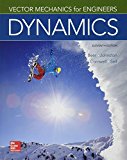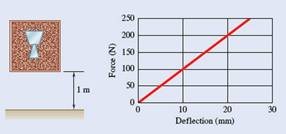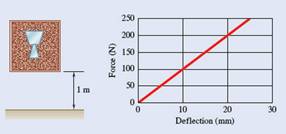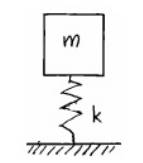
Concept explainers
A 5-kg fragile glass vase is surrounded by packing material in a cardboard box of negligible weight. The packing material has negligible damping and a force-deflection relationship as shown. Knowing that the box is dropped from a height of 1 m and the impact with the ground is perfectly plastic, determine (a) the amplitude of vibration for the vase, (b) the maximum acceleration the vase experiences in g' s.

(a)
The amplitude of vibration for the vase.
Answer to Problem 19.10P
Amplitude
Explanation of Solution
Given information:

Mass of vase
Height
Velocity at the end of free fall
Assume that the spring is unstretched during the free fall. To better understand we use a simple spring mass model for the motion of the vase and the packing material.
Now, taking slope from the graph.

Calculation:
Now, consider simple harmonic motion:
We can obtain the velocity (v) at any time (t) by differentiating (x) with respect to (t),
When the box hits the ground, let
Then, at
And, velocity,
So, velocity of the vase = velocity at the end of free fall
Now, Natural frequency:
Thus, amplitude of the vase
Conclusion:
The amplitude of the vase is
(b)
The maximum acceleration the vase experiences.
Answer to Problem 19.10P
Acceleration
Explanation of Solution
Given information:

Mass of vase
Height
Velocity at the end of free fall
Assume that the spring is unstretched during the free fall. To better understand we use a simple spring mass model for the motion of the vase and the packing material.
Now, taking slope from the graph.

Calculation:
Now, consider simple harmonic motion:
We can obtain the velocity (v) at any time (t) by differentiating (x) with respect to (t),
When the box hits the ground, let
Then, at
And, velocity,
So, velocity of the vase = velocity at the end of free fall
Now, Natural frequency:
Thus, amplitude of the vase
And, maximum acceleration of the vase,
Conclusion:
Maximum acceleration of the vase is
Want to see more full solutions like this?
Chapter 19 Solutions
Package: Vector Mechanics For Engineers: Dynamics With 1 Semester Connect Access Card
- A machine of mass 75 kg is mounted on springs and is fitted with a dashpot to damp out vibrations. There are three springs each of stiffness 10 N/mm and it is found that the amplitude of vibration diminishes from 38.4 mm to 6.4 mm in two complete oscillations. Assuming that the damping force varies as the velocity, determine : 1. the resistance of the dash-pot at unit velocity ; 2. the ratio of the frequency of the damped vibration to the frequency of the undamped vibration ; and 3. the periodic time of the damped vibration.arrow_forwardA 36-lb motor is bolted to a light horizontal beam that has a static deflection of 0.075 in. due to the weight of the motor. Knowing that the unbalance of the rotor is equivalent to a weight of 0.64 oz located 6.25 in. from the axis of rotation, determine the amplitude of the vibration of the motor at a speed of 900 rpm, assuming (a ) that no damping is present, (b ) that the damping factor c/cc is equal to 0.055.arrow_forwardA 64-lb block is attached to a spring with a constant of k = 1 kip/ft and can move without friction in a vertical slot as shown. It is acted upon by a periodic force with a magnitude of P=Pm sin wf t = 10 rad/s. Knowing that the amplitude of the motion is 0.75 in., determine Pm.arrow_forward
- A 11-lb block is attached to the lower end of a spring whose upper end is fixed and vibrates with a period of 7.2 s. Knowing that the constant k of a spring is inversely proportional to its length (e.g., if you cut a 10 lb/in. spring in half, the remaining two springs each have a spring constant of 20 lb/in.), determine the period of a 7-lb block that is attached to the center of the same spring if the upper and lower ends of the spring are fixed.arrow_forwardA spring-mass-damper system has a mass of 80 kg suspended from a spring having stiffness of 1000 N/m and a viscous damper with a damping coefficient of 80 N-s/m. If the mass is subjected to a periodic disturbing force of 50 N at an undamped natural frequency, determine (i) The undamped natural frequency. (ii) The damped natural frequency. (iii) The amplitude of forced vibration of mass. (iv) The phase difference.arrow_forwardA 45-kg motor is bolted to a light horizontal beam that has a static deflection of 6 mm due to the weight of the motor. The unbalance of the motor is equivalent to a mass of 110 g located 75 mm from the axis of rotation. Knowing that the amplitude of the vibration of the motor is 0.25 mm at a speed of 300 rpm, determine (a) the damping factor c/cc(b) the coefficient of damping c.arrow_forward
- A vibrometer used to measure the amplitude of vibrations consists essentially of a box containing a mass-spring system with a known natural frequency of 120 Hz. The box is rigidly attached to a surface that is moving according to the equation y= δm sin wf t. If the amplitude zm of the motion of the mass relative to the box is used as a measure of the amplitude δm of the vibration of the surface, determine (a) the percent error when the frequency of the vibration is 600 Hz,(b) the frequency at which the error is zero.arrow_forwardIn the case of the forced vibration of a system, determine the range of values of the damping factor c/cc for which the magnification factor will always decrease as the frequency ratio wf/wn increases.arrow_forward3. The 7.5 kg mass shown is vibrating freely with the following spring attached to it. If the required period of vibration is 0.35s, determine (a) the value of the spring stiffness constant R and (b) the vibration response with initial displacement and velocity of 5cm and 24 cm/s, respectivelyarrow_forward
 Elements Of ElectromagneticsMechanical EngineeringISBN:9780190698614Author:Sadiku, Matthew N. O.Publisher:Oxford University Press
Elements Of ElectromagneticsMechanical EngineeringISBN:9780190698614Author:Sadiku, Matthew N. O.Publisher:Oxford University Press Mechanics of Materials (10th Edition)Mechanical EngineeringISBN:9780134319650Author:Russell C. HibbelerPublisher:PEARSON
Mechanics of Materials (10th Edition)Mechanical EngineeringISBN:9780134319650Author:Russell C. HibbelerPublisher:PEARSON Thermodynamics: An Engineering ApproachMechanical EngineeringISBN:9781259822674Author:Yunus A. Cengel Dr., Michael A. BolesPublisher:McGraw-Hill Education
Thermodynamics: An Engineering ApproachMechanical EngineeringISBN:9781259822674Author:Yunus A. Cengel Dr., Michael A. BolesPublisher:McGraw-Hill Education Control Systems EngineeringMechanical EngineeringISBN:9781118170519Author:Norman S. NisePublisher:WILEY
Control Systems EngineeringMechanical EngineeringISBN:9781118170519Author:Norman S. NisePublisher:WILEY Mechanics of Materials (MindTap Course List)Mechanical EngineeringISBN:9781337093347Author:Barry J. Goodno, James M. GerePublisher:Cengage Learning
Mechanics of Materials (MindTap Course List)Mechanical EngineeringISBN:9781337093347Author:Barry J. Goodno, James M. GerePublisher:Cengage Learning Engineering Mechanics: StaticsMechanical EngineeringISBN:9781118807330Author:James L. Meriam, L. G. Kraige, J. N. BoltonPublisher:WILEY
Engineering Mechanics: StaticsMechanical EngineeringISBN:9781118807330Author:James L. Meriam, L. G. Kraige, J. N. BoltonPublisher:WILEY





